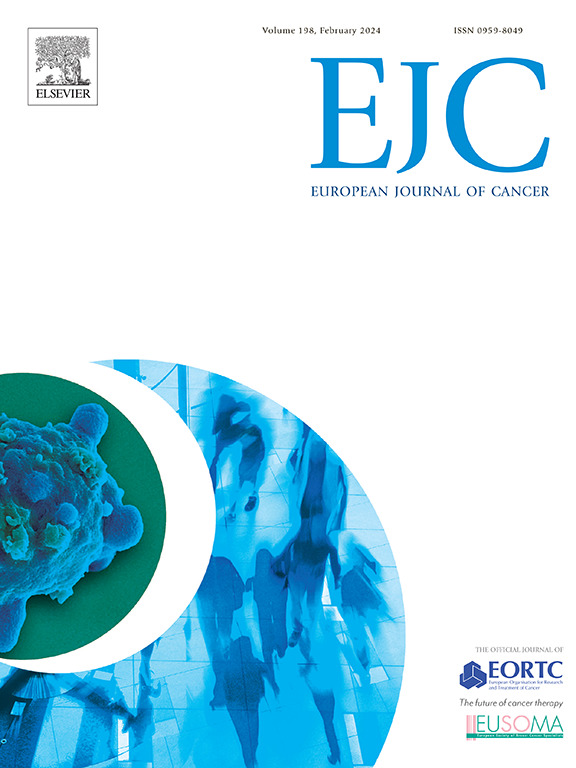表皮生长因子受体(EGFR)突变的非小细胞肺癌的小细胞转化:DLL3 表达与免疫检查点抑制剂或酪氨酸激酶抑制剂联合化疗的疗效。
IF 7.6
1区 医学
Q1 ONCOLOGY
引用次数: 0
摘要
导言:小细胞转化(SCT)是对第三代表皮生长因子受体抑制剂(EGFRi)产生适应性耐药的一种典型机制,而第三代表皮生长因子受体抑制剂已成为治疗表皮生长因子受体(EGFR)驱动的非小细胞肺癌(EGFR+ NSCLC)的标准疗法。人们对SCT患者的最佳治疗方法知之甚少。本研究旨在比较铂/依托泊苷单独化疗(化疗)或与表皮生长因子受体抑制剂(EGFRi+化疗)或免疫检查点抑制剂(ICI+化疗)联合化疗的疗效。此外,我们还探索了DLL3的表达,将其作为潜在的新型治疗靶点:我们对在欧洲和美国 19 个中心接受治疗的表皮生长因子受体(EGFR)+ NSCLC 和 SCT 患者进行了一项回顾性研究。共纳入 47 例患者,其中 17 例接受化疗,20 例 ICI+ 化疗,10 例 EGFRi+ 化疗。我们通过免疫组化分析了DLL3的表达:在整个队列中,自首次SCT治疗开始的中位总生存期(OS)为11个月(95%置信区间[95 %CI] 9.1-12.9),中位无进展生存期(PFS)为5个月(95 %CI 4.2-5.8)。三组的中位生存期相似(化疗和ICI+化疗为4个月,EGFRi+化疗为6个月),ICI+化疗、EGFRi+化疗和化疗的12个月生存期分别为12%(95%CI为2%-31%)、13%(95%CI为0%-43%)和0%。ICI+化疗组的中位OS为13个月(95 %CI 5.5-20.5),而化疗组和EGFRi+化疗组的中位OS分别为10个月(95 %CI 7.6-12.4)和(95 %CI 8.1-11.9)。SCT前后,分别有0%和93%的肿瘤呈DLL3阳性:我们的研究结果表明,对于接受SCT的表皮生长因子受体(EGFR)+ NSCLC而言,ICI+化疗和DLL3靶向药物值得进一步探索:本研究的部分成果已于 2023 年 10 月在西班牙马德里举行的 ESMO 年会上发表(海报 1336 P)。本文章由计算机程序翻译,如有差异,请以英文原文为准。
Small cell transformation in EGFR-mutated non-small cell lung cancer: DLL3 expression and efficacy of immune checkpoint inhibitors or tyrosine kinase inhibitors combined with chemotherapy
Introduction
Small cell transformation (SCT) is a typical mechanism of adaptive resistance to third generation epidermal growth factor receptor inhibitors (EGFRi) which have become the standard of care for EGFR-driven non-small cell lung cancer (EGFR+ NSCLC). Little is known about the optimal management of SCT patients. This study aimed to compare outcomes under platinum/etoposide chemotherapy alone (chemo) or in combination with EGFR inhibitors (EGFRi+chemo) or immune checkpoint inhibitors (ICI+chemo). In addition, DLL3 expression was explored as potential novel therapeutic target.
Methods
We conducted a retrospective study on patients with EGFR+ NSCLC and SCT treated at 19 centers in Europe and the United States. A total of 47 patients were included of whom 17 received chemo, 20 ICI+chemo, and 10 EGFRi+chemo. We analyzed DLL3 expression by immunohistochemistry.
Results
In the entire cohort, median overall survival (OS) from start of first SCT therapy was 11 months (95 % confidence interval [95 %CI] 9.1–12.9) and median progression-free survival (PFS) was 5 months (95 %CI 4.2–5.8). Median PFS was similar in all three groups (chemo and ICI+chemo 4 months, EGFRi+chemo 6 months), and 12-months PFS was 12 % (95 %CI 2 %−31 %), 13 % (95 %CI 0 %−43 %), and 0 % for ICI+chemo, EGFRi+chemo, and chemo, respectively. Median OS in the ICI+chemo group was 13 months (95 %CI 5.5–20.5) compared to 10 months (95 %CI 7.6–12.4) with chemo and EGFRi+chemo (95 %CI 8.1–11.9), respectively. Before and after SCT, 0 % and 93 % of tumors were DLL3-positive.
Conclusions
Our results suggest that ICI+chemo and DLL3-targeting agents are worth further exploration in EGFR+ NSCLC undergoing SCT.
Presented elsewhere
Part of this work has been presented at ESMO annual meeting in Madrid, Spain in October 2023 (Poster 1336 P).
求助全文
通过发布文献求助,成功后即可免费获取论文全文。
去求助
来源期刊

European Journal of Cancer
医学-肿瘤学
CiteScore
11.50
自引率
4.80%
发文量
953
审稿时长
23 days
期刊介绍:
The European Journal of Cancer (EJC) serves as a comprehensive platform integrating preclinical, digital, translational, and clinical research across the spectrum of cancer. From epidemiology, carcinogenesis, and biology to groundbreaking innovations in cancer treatment and patient care, the journal covers a wide array of topics. We publish original research, reviews, previews, editorial comments, and correspondence, fostering dialogue and advancement in the fight against cancer. Join us in our mission to drive progress and improve outcomes in cancer research and patient care.
 求助内容:
求助内容: 应助结果提醒方式:
应助结果提醒方式:


